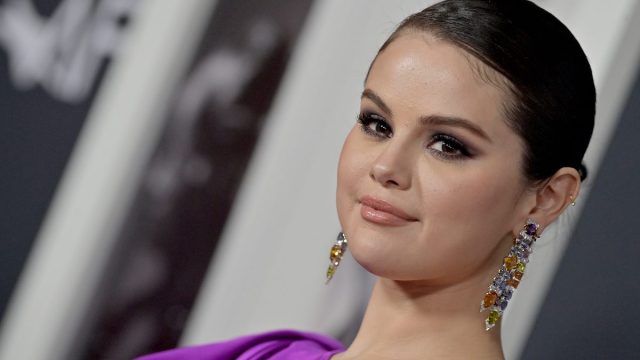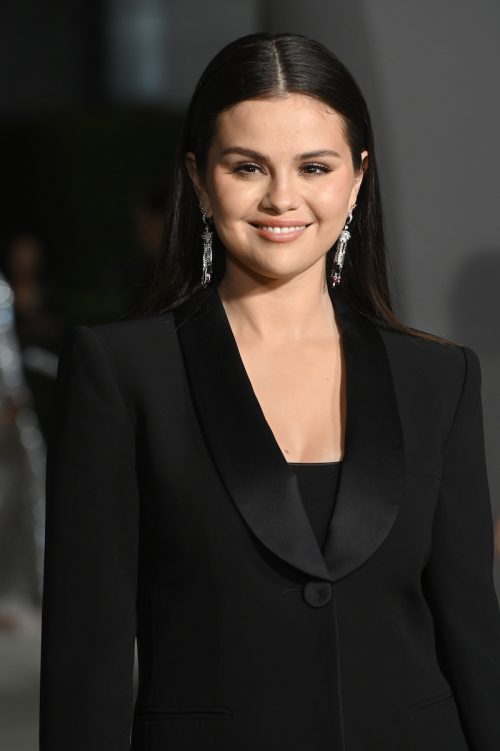Selena Gomez Opens Up About Symptoms That Led to "Psychotic Break"
The singer and actor was treated for psychosis in 2018 and shares her experience in a new documentary.

Singer, actor, and beauty brand founder Selena Gomez's new documentary is so raw and honest that she considered never releasing it. Selena Gomez: My Mind & Me documents the 30-year-old's struggles with her mental health, including her bipolar disorder diagnosis and an experience with psychosis in 2018.
"Because I have the platform I have, it's kind of like I'm sacrificing myself a little bit for a greater purpose," she told Rolling Stone ahead of the film's Nov. 4 release on Apple TV+. "I don't want that to sound dramatic, but I almost wasn't going to put this out. God's honest truth, a few weeks ago, I wasn't sure I could do it."
In the interview, Gomez spoke about her "psychotic break," the symptoms she experienced, and how she learned to live with her diagnosis afterward. Read on to learn what led up to her most serious mental issues and why she decided to share all of this with her fans.
READ THIS NEXT: Selena Gomez Explains Her Most Embarrassing Red Carpet Look.
Gomez began to feel "not in control" when she was in her early twenties.

Gomez explained to Rolling Stone that, prior to being diagnosed with bipolar disorder (which she shared publicly two years ago), she had thoughts and feelings that she didn't understand.
"I'm going to be very open with everybody about this: I've been to four treatment centers," the Only Murders in the Building star said. "I think when I started hitting my early twenties is when it started to get really dark, when I started to feel like I was not in control of what I was feeling, whether that was really great or really bad."
She went through periods of mania and depression, without knowing they were symptoms of bipolar disorder. For instance, she felt she needed to buy everyone she knows a car. "I have a gift and I wanted to share it with people," she explained that she felt at the time.
Then there were the lows. "It would start with depression, then it would go into isolation," Gomez recalled. "Then it just was me not being able to move from my bed. I didn't want anyone to talk to me. My friends would bring me food because they love me, but none of us knew what it was. Sometimes it was weeks I'd be in bed, to where even walking downstairs would get me out of breath." She said that she never attempted to end her life, but "thought the world would be better if [she] wasn't there."
She "heard voices" and eventually was treated for psychosis.

In 2018, Gomez had an episode of psychosis and was hearing voices. According to Rolling Stone, she doesn't remember much about this period, but she spent time in a treatment facility where she experienced paranoia for months. She described the end of this time as "walking out of psychosis."
It was reported by People in 2018 that Gomez had sought treatment for "her ongoing emotional issues."
For more celebrity news delivered right to your inbox, sign up for our daily newsletter.
She was prescribed medicine that came with side effects.

Gomez was diagnosed with bipolar disorder and put on medications to treat it. But, because of the drugs, "There was no part of me that was there anymore," she said. She sought help from another doctor, her treatment plan was changed, and she was put on medicines that actually worked for her.
"I had to detox, essentially, from the medications I was on," the 30-year-old explained. "I had to learn how to remember certain words. I would forget where I was when we were talking. It took a lot of hard work for me to (a) accept that I was bipolar, but (b) learn how to deal with it because it wasn't going to go away."
She's sharing all of this to help others.
Through her documentary and her philanthropic work, Gomez is focused on encouraging others to deal with their mental health issues. She sees this as her purpose in life.
"I just constantly remind myself that there's a reason I'm here," she told Rolling Stone. "It sounds really cheesy when I say it sometimes, but I truly don't know how else I'd be here, simply based on the medical stuff and balances in my head and conversations I'd had with myself [that were] really dark." In addition to having bipolar disorder, Gomez has lupus and had to receive a kidney transplant in 2017 due to the autoimmune disease.
She also sees how much her experiences have shaped her. "I remind myself that I wouldn't be here if it wasn't for the psychotic break, if it wasn't for my lupus, if it wasn't for my diagnosis," she said. "I think I would just probably be another annoying entity that just wants to wear nice clothes all the time. I'm depressed thinking about who I would be."
Her diagnosis was "a huge weight lifted."

Prior to the release of her documentary, which reveals some aspects of Gomez's journey that she hadn't spoken about publicly before, the star was already a mental health advocate. Her efforts included speaking about mental health on a panel at the White House and pledging to raise $100 million from her brand Rare Beauty to support mental healthcare access in underserved communities.
"I felt a huge weight lifted off me when I found out," she told Elle of her bipolar diagnosis in 2021. "I could take a deep breath and go, 'Okay, that explains so much.'"
In the same interview, she said, "My lupus, my kidney transplant, chemotherapy, having a mental illness, going through very public heartbreaks—these were all things that honestly should have taken me down. Every time I went through something, I was like, 'What else? What else am I going to have to deal with?'"
Gomez went on to say that she told herself in the hardest times that she was "going to help people."
"That's really what kept me going," she continued. "There could have been a time when I wasn't strong enough, and would have done something to hurt myself."





















